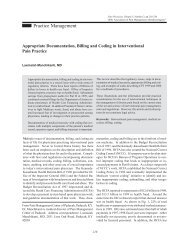ASIPP Practice Guidelines - Pain Physician
ASIPP Practice Guidelines - Pain Physician
ASIPP Practice Guidelines - Pain Physician
Create successful ePaper yourself
Turn your PDF publications into a flip-book with our unique Google optimized e-Paper software.
Manchikanti et al • <strong>ASIPP</strong> <strong>Practice</strong> <strong>Guidelines</strong><br />
60<br />
intervention of the spine, leakage of the disc material into<br />
the epidural space following an annular tear has also been<br />
reported to cause fibrocyte deposition and an inflammatory<br />
response that can subsequently result in the formation<br />
of epidural adhesions (227, 636, 637). It has been presumed<br />
that inflammation and compression of nerve roots<br />
by epidural adhesions is the mechanism of persistent pain<br />
in patients. The causes of failed back surgery syndrome or<br />
postlumbar laminectomy syndrome are epidural scarring,<br />
arachnoiditis, recurrent disc herniation with neural encroachment,<br />
mechanical instability, and facet degeneration.<br />
While it is largely agreed that peridural scarring contributes<br />
to a considerable amount of morbidity and mortality<br />
following lumbar surgery, further surgery is not a solution,<br />
as results show disappointing success rates as low as 12%<br />
(280, 638). Further, epidural adhesions are not readily<br />
diagnosed by conventional studies such as myelography,<br />
CT, and MRI, even though modern technology has made<br />
significant improvements in this area (637). The epidural<br />
adhesions are best diagnosed by performing an<br />
epidurogram, which is most commonly performed via the<br />
caudal route, followed by other routes, including the lumbar<br />
interlaminar route, and thoracic and cervical<br />
interlaminar routes (525, 527, 632-634, 636, 639-641).<br />
Epidural filling defects have also been shown in a significant<br />
number of patients with no history of prior surgery<br />
(525). While peridural scarring in itself is not painful, it<br />
can produce pain by “trapping” spinal nerves so that movement<br />
places tension on the inflamed nerves (633, 634, 639).<br />
Kuslich and coworkers (153) reported that back pain was<br />
produced by stimulation of several lumbar tissues, even<br />
though the outer layer of the annulus fibrosus and posterior<br />
longitudinal ligament innervated by the sinuvertebral<br />
nerves were the most common tissues of origin.<br />
Adhesiolysis of epidural scar tissue, followed by the injection<br />
of hypertonic saline, has been described by Racz<br />
and coworkers in multiple publications (632-635, 636, 639,<br />
644, 645). The technique described by Racz and colleagues<br />
involved epidurography, adhesiolysis, and injection of hyaluronidase,<br />
bupivacaine, triamcinolone diacetate, and 10%<br />
sodium chloride solution on day 1, followed by injections<br />
of bupivacaine and hypertonic sodium chloride solution<br />
on days 2 and 3. Manchikanti and colleagues (632, 646,<br />
649) modified the Racz protocol from a 3-day procedure<br />
to a 1-day procedure.<br />
The purpose of percutaneous epidural lysis of adhesions is<br />
to eliminate deleterious effects of scar formation, which<br />
can physically prevent direct application of drugs to nerves<br />
or other tissues to treat chronic back pain. In addition, the<br />
goal of percutaneous lysis of epidural adhesions is to assure<br />
delivery of high concentrations of injected drugs to<br />
the target areas.<br />
Clinical effectiveness of percutaneous adhesiolysis was<br />
evaluated in one randomized controlled trial (647, 648)<br />
and four retrospective evaluations (636, 646, 649, 650).<br />
Racz and colleagues (647), and Heavner and coworkers<br />
(648), studied percutaneous epidural adhesiolysis, with a<br />
Table 13. Results of published reports of percutaneous lysis of lumbar epidural adhesions<br />
and hypertonic saline neurolysis for a single procedure<br />
Author(s)<br />
Study<br />
Characteristics<br />
No. of<br />
Patients<br />
Drugs Utilized<br />
No. of<br />
Days of<br />
Procedure<br />
Initial Relief<br />
1-4<br />
Weeks<br />
Long-term Relief<br />
3 Months 6 Months<br />
Heavner et al (648) P, RA, PC 59 B, T, H, HS, NS 3 83% 49% 43%<br />
Racz and Holubec<br />
(636)<br />
Manchikanti et al<br />
(646)<br />
Manchikanti et al<br />
(646)<br />
Manchikanti et al<br />
(649)<br />
R, RA 72 B, T, H, HS 3 65% 43% 13%<br />
R, RA 103 M, L, HS 2 74% 37% 21%<br />
R, RA 129 M, L, HS 1 79% 26% 14%<br />
R 60 L, HS, CS 1 100% 25% 10%<br />
Arthur et al (650) R, RA 100 L, HS, CS, H 1 82% NA 14%<br />
P = prospective; PC = placebo controlled; R = retrospective; RA = randomized; B = bupivacaine; L = lidocaine;<br />
T = triamcinolone; M = methylprednisolone; CS = celestone soluspan; H = hyaluronidase; HS = hypertonic saline;<br />
NS = normal saline; NA = not available<br />
<strong>Pain</strong> <strong>Physician</strong> Vol. 4, No. 1, 2001
















